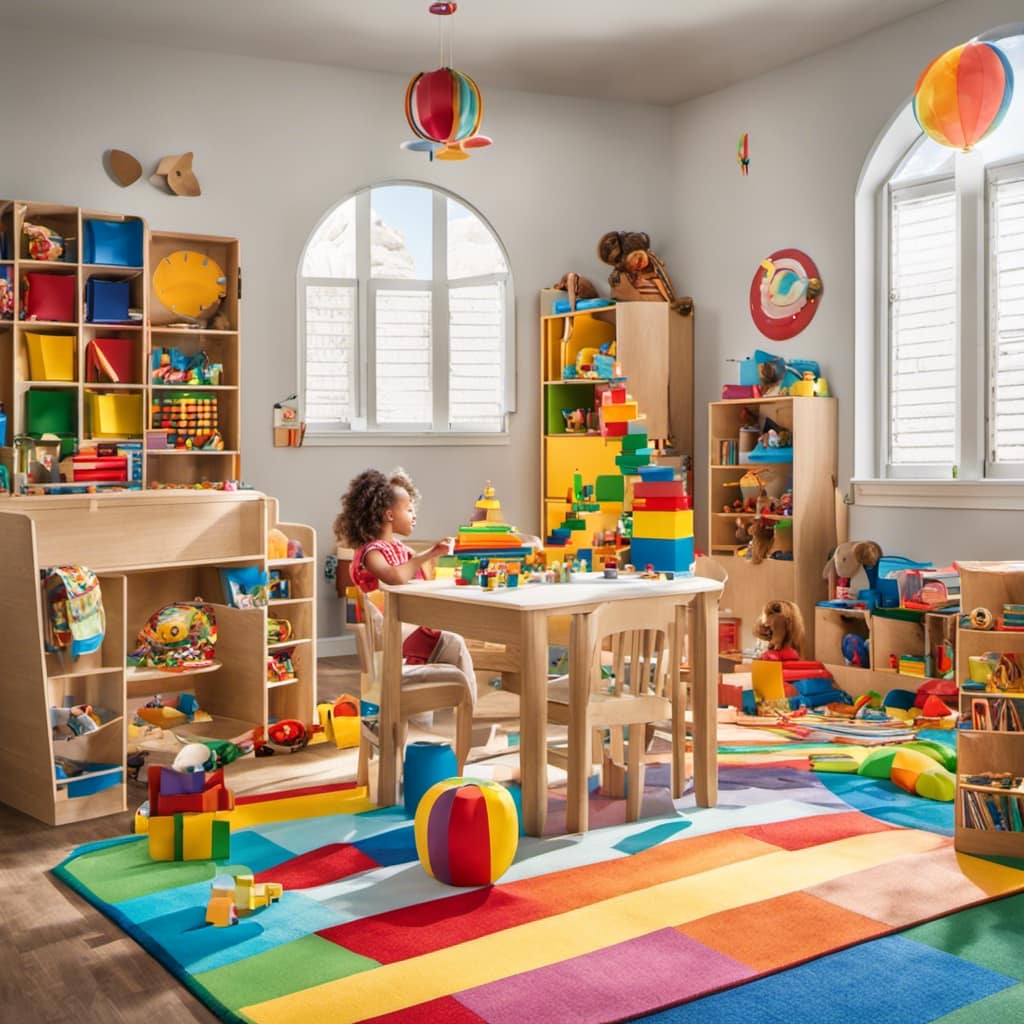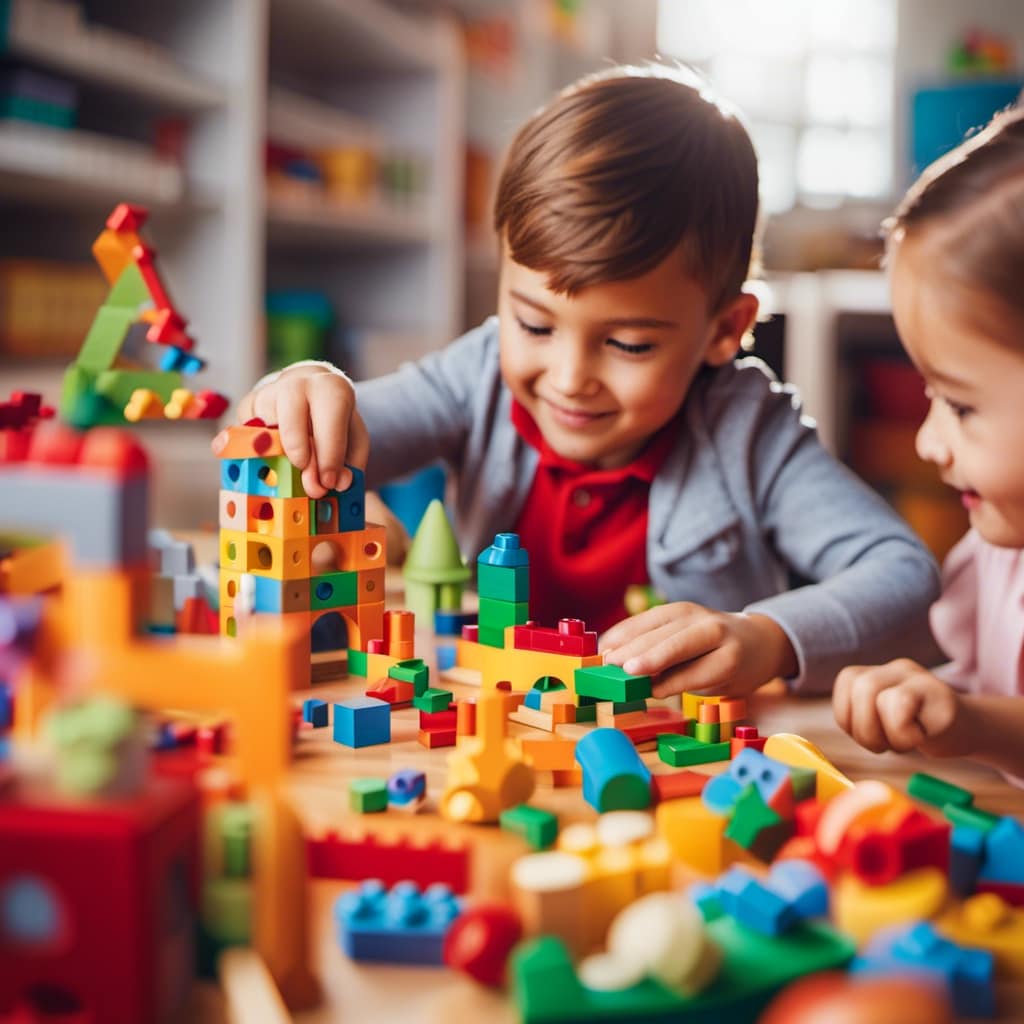Waldorf toys have no batteries to encourage your child’s imagination and creative thinking. Without electronic features, your child can freely explore, build, and transform toys into whatever they envision. This open-ended play helps develop problem-solving skills, emotional growth, and sensory awareness. It also promotes meaningful interaction with others and a deeper connection with their surroundings. Keep exploring to discover how these simple toys can nurture long-term creativity and resilience in your child’s development.
Key Takeaways
- Waldorf toys lack batteries to encourage imaginative, open-ended play beyond preset electronic functions.
- Battery-free toys promote creativity, problem-solving, and sensory development through natural materials.
- Removing batteries fosters mindful interaction and deeper connections with children’s inner worlds.
- Open-ended, battery-free toys support adaptability and independent thinking in children.
- They help children invent and transform toys, nurturing innovation and resilience over electronic entertainment.

Have you ever wondered how children develop creativity and problem-solving skills? It’s a fascinating process, one that unfolds through open-ended play. Unlike toys with preset functions or electronic gadgets that do everything for them, Waldorf toys encourage kids to use their imagination and think outside the box. When children engage with these simple, natural toys, they’re not just playing—they’re building their creative development. These toys serve as blank canvases, inviting children to transform, adapt, and invent as they see fit. That imaginative exploration is essential; it allows kids to experiment with different scenarios, roles, and stories, fostering a deep sense of curiosity and innovation. As they manipulate wooden blocks, felt figures, or cloth dolls, they learn to see beyond the toy itself and imagine new possibilities, which sharpens their problem-solving abilities.
Open-ended Waldorf toys inspire creativity, problem-solving, and imaginative exploration in children.
Open-ended play with Waldorf toys is powerful because it removes the boundaries that often come with electronic toys. When kids aren’t limited by batteries or preset functions, they’re free to explore their ideas fully. They might build a castle one day and then turn it into a spaceship the next, constantly shifting their perspective and challenging their brains to think creatively. This kind of play nurtures their ability to adapt and find solutions on their own—skills that are fundamental as they grow. Plus, with no batteries, the focus stays on the child’s inner world, not on the toy’s technology. It encourages mindfulness and presence, helping children develop a deeper connection with their surroundings and their own thoughts. Additionally, developmental benefits from nurturing these skills early on can have lasting impacts on their academic and social success.
Another benefit of Waldorf toys’ simplicity is that it sparks more meaningful interactions. Children often invite friends or family into their imaginative worlds, sharing stories and collaborating on their creative projects. This social aspect enhances their communication skills and emotional understanding. Because the toys are often made from natural materials, they also promote sensory development. Kids can feel different textures and observe subtle colors, which further stimulates their senses and supports their overall growth.
In essence, open-ended play with Waldorf toys doesn’t just entertain—it cultivates essential skills. It helps children become confident problem-solvers, inventive thinkers, and emotionally aware individuals. By choosing toys that prioritize creative development and imaginative exploration over batteries and bells, you’re giving your child the space to develop their unique talents and passions. That kind of play sets the foundation for lifelong curiosity and resilience, preparing them for a future where they can think critically and creatively about the world around them.
Frequently Asked Questions
How Do Waldorf Toys Support Child Development?
Waldorf toys support your child’s development by encouraging imaginative play and sensory development. You’ll notice your child engaging creatively with simple, natural materials, which helps build their problem-solving skills and emotional intelligence. These toys foster curiosity and focus, allowing your child to explore and learn at their own pace. Without batteries or electronic distractions, your child can fully immerse in play, nurturing their cognitive and sensory growth naturally and holistically.
Are Waldorf Toys Suitable for All Ages?
You might wonder if Waldorf toys suit all ages. They’re designed with safety considerations, ensuring materials are non-toxic and durable, making them suitable for infants through older children. Plus, their cultural significance fosters respect for traditions and natural materials. As a parent or caregiver, you’ll appreciate that these toys grow with your child, encouraging creativity and open-ended play at every stage, while prioritizing safety and cultural richness.
How Do Waldorf Toys Compare to Electronic Toys?
You might think electronic toys are the kings of fun, but compare them to Waldorf toys, and it’s like night and day! While digital stimulation from electronics can cause sensory overload, Waldorf toys offer gentle, open-ended play that sparks imagination. You’ll notice how they encourage creativity and focus, unlike the instant gratification of batteries and flashing lights. Waldorf toys nurture your child’s natural curiosity, making playtime richer and more meaningful.
Can Waldorf Toys Be Used Outdoors?
You can definitely use Waldorf toys outdoors, and they’re perfect for nature exploration and outdoor creativity. These toys are made from natural materials, so they withstand the elements better than electronic toys. When you take them outside, they encourage your child to engage with nature, fostering imagination and sensory experience. Just keep an eye on the weather, and your child will enjoy hours of open-ended play in the fresh air.
What Materials Are Commonly Used in Waldorf Toys?
You’ll find that Waldorf toys are made from natural fibers like wool, cotton, and wood, which promote safety and sensory development. These toys are crafted using traditional, handcrafted techniques, ensuring each piece is unique and high-quality. The focus on natural materials aligns with the Waldorf philosophy, encouraging imaginative play without relying on batteries or electronics. This approach helps foster creativity, patience, and a closer connection to nature in your child.
Conclusion
Choosing Waldorf toys without batteries encourages open-ended play, nurturing creativity and imagination. For example, a child with simple wooden blocks might create endless structures, developing problem-solving skills and independence. Unlike electronic toys that limit your child’s imagination, these natural toys grow with them, offering new possibilities at every stage. By embracing open-ended play, you give your child the freedom to explore, invent, and learn—building a strong foundation for lifelong curiosity and growth.











